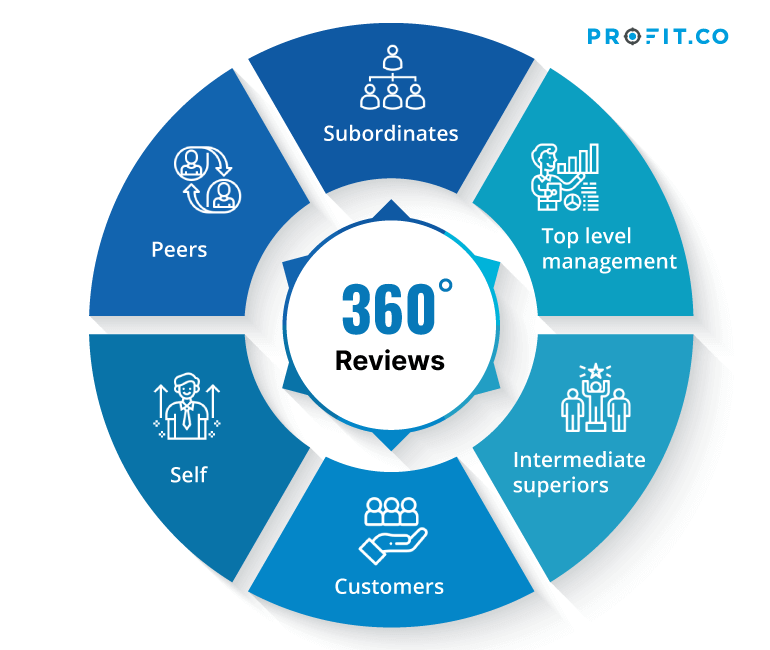360 degree performance reviews have become more and more popular over the years. Previously, this in-depth process was only used to evaluate senior executives and other high level employees within a company. This time-consuming performance review had to be used sparingly to avoid wasting time and resources. However, with new technology that enables more transparent company cultures and expedited performance reviews, 360 reviews have become more commonplace among all levels within an organization.
I have yet to find a man, however exalted his station, who did not do better work and put forth greater effort under a spirit of approval than under a spirit of criticism.
This change is ultimately for the better. It’s undeniable that 360 degree performance reviews offer a more comprehensive perspective on employee performance. However, before diving into the 360 degree feedback process, there are a few things to consider.
Traditionally, 360 reviews have been done for the following reasons:
- To gather multiple perspectives on employee performance from peer reviewers, key stakeholders, and direct reports. 360 degree performance reviews can be used to gather feedback on managers from employees as well.
- As an intervention designed to carefully review an employee’s performance when the manager has concerns about the employee’s productivity or development, or if the manager feels the employee’s values do not align with the values and behaviors of the company.
- To gather feedback from different groups of people to help an individual succeed and create professional development goals for an employee or plan out their career trajectory.
While the intention of the 360 reviews is positive and can be incredibly beneficial, it truly depends on the quality of the reviews submitted. The employee may benefit from it, or may not. The value that comes from the review is dependent on why the 360 degree performance review was initiated, how it was delivered, and what action items came after the feedback was given. For example, was a
performance improvement plan initiated? Or is the employee carrying on business as usual?
The 360 degree performance review is a valuable tool to have at your disposal. It is a great way to conduct an unbiased performance review, and brings in feedback from co-workers, managers, and sometimes even clients to get a full picture of employee performance. The unbiased feedback gives an insight into the employee’s performance that would otherwise have been overlooked. It gives an opportunity for coworkers to give feedback and support the employee’s growth and development in the organization.
However, this method is effective only if the reviewer’s identity is confidential, and the feedback and the objective behind the review itself is transparent.
No matter what approach is used to conduct the feedback process, whether online or using in-depth in-person interviews conducted by a third party, these areas need to be dealt with very carefully.
Following are a few reasons why each is important:
Confidentiality
- When coworkers know that their comments and feedback would be kept confidential, they can be more honest and direct about their feedback. However, many have a nagging worry at the back of their minds that their responses might not be truly confidential.
- When it comes to collecting performance reviews through online feedback surveys, having a credible vendor can be reassuring to respondents knowing that their feedback will not be accessible to anyone within the organization. HR needs to make it very clear how they are going about maintaining and ensuring confidentiality.
- When the 360 review process is done through in-depth interviews, the interviewer needs to make it very clear to the interviewees that their responses will be kept confidential so that the performance review is less stressful and more productive.
Be transparent
- While conducting 360 degree performance reviews, HR and the reviewed employee’s manager need to be completely transparent with the individual conducting the review about the objective of the 360 review.
Is it to address a certain aspect of performance, or is it for overall improvement and development in performance? For the assessment to be productive, it’s very important that the real objectives be shared with the person conducting the reviews. If there is no transparency, the reviewer might not ask the right questions, and the review itself will have been a waste of time.
Are you looking for a performance management software to manage employee reviews? Get started with Profit.co today and check out our customizable and comprehensive performance management module to help evaluate and improve your team today!

How to get the most out of the 360 reviews:
The intent for all 360 degree performance reviews should be to help the employee learn and grow.
Using this process purely for corrective action isn’t the best method, because many times it’s not necessary for peers to pile on complaints. You can investigate a certain capability or overall performance with this performance review system, but turn to more private methods for reprimanding employees.
The 360 degree performance review survey should be designed to highlight what the employee is doing well. Keep it positive and focused on development; ask what can be improved, what skills can be developed, and what kind of training would benefit the employee. All feedback should be relevant, clear, and actionable. Give effective feedback by highlighting the specifics of how an employee can adjust their work habits or improve their skills.
Five key things to do for an effective and useful 360 degree review:
- Customize the 360 degree performance review
- Be prepared for the criticism in results
- Stay positive
- Identify gaps
- Develop an action plan post review
1. Customize the 360 degree performance review
The 360 degree performance review can be customized based on an organization’s culture, competencies, vision, mission, any changes it might have gone through (like a merger with another company and therefore how it would relate to the new entities). HR typically will have to choose performance appraisal questions from their resources or build survey questions from scratch.
2. Be prepared for the criticism in results
There are benefits to the 360 degree assessment process. But one also needs to be mentally prepared to hear the results and constructive criticism. In order to make reviewed employees more receptive to difficult feedback, make sure that you highlight the opportunities for development and the benefits of the 360 degree performance review. You can also give the participant some control over the assessment process, such as timing, confidentiality, action plans and participants.
3. Stay positive
It’s safe to assume that everyone providing the employee with feedback is trying to be helpful. In order to get the most of the feedback, it’s important to take the 360 degree experience in the right spirit. The 360-degree performance review gives the employee the opportunity to gain insight about her or himself that they may never have received otherwise, and this is especially true for senior-level employees. Rather than react to any feedback with shock, anger or resistance, consider it as an opportunity for self-awareness to help grow as a person and professional.
4. Identify gaps
360 degree performance reviews are ultimately subjective and based on performance that other people observe from their perspective. Therefore, it’s important to see if there are any gaps in perception. Does the reviewed employee see themself differently than their reviewers do? Does the reviewed employee’s peers view them differently than their direct reports? How does their manager view them?
Going over everybody’s viewpoints can help determine whether the reviewed employee behaves differently among different groups of people. If there are significant differences in how each group or individual perceived the reviewed employee, it’s important to explore why it is so.
5. Develop an action plan post review
After the 360 degree performance review is complete, the individual who conducted the interview should produce a documented performance report. But that’s not all; the reviewed employee should also sit down with their manager and an HR representative to have a discussion about their results, and develop a plan of action based on their feedback.
If an employee needs to modify their behavior, they should have a clear development plan that will bring about change. This plan should be developed by the employee and their manager together, with follow-up meetings to discuss progress and performance.
It’s very important to have this development plan in place after an employee’s 360 review is complete. The next steps garnered from the performance review itself is where the true benefit of this performance management system lies. Make sure that you and your team are acting on the valuable insights from these performance reviews and are taking care of issues that are revealed through this process so that employees, managers, and the company as a whole can improve together.
In Conclusion
The 360 degree performance review doesn’t end after all reviewers submit their feedback. Responses must be considered, analyzed, and acted on in order for teams to reap the full benefits of this in-depth and highly effective performance management system. Continually returning to this type of performance review can have substantial, long-term benefits for your team.
To make 360 reviews a continuous part of your business, you can manage performance using an agile and customizable performance software such as Profit.co. To learn more about how a performance management software can optimize your 360 degree performance review process and improve your company, book a free demo with our team!

